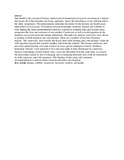| dc.description.abstract | One health is the concept of human, animal and environmental ecosystem coexisting in a balance
that keeps all of them healthy and living optimally, where the disturbance of one element affects the
other components. This phenomenon underpins the desire for the holistic one health study approach
in an ecosystem. In Samburu ecosystem humans, domestic animals and wildlife co-exist sharing the
same environmental resources, exposed to common risks and in some cases antagonize the lives and
existence of one another. Carnivores as well as wild ungulates in the Sumburu ecosystem roam into
human settlements. Through scat analysis carnivores were shown to predate on both domestic and
wild animals. There are a number of records of humans’ injuries. The carnivores, most notably the
hyena share their denning sites with humans, while the wild ungulates grazed and watered together
with domestic animals. This human carnivores and prey base interaction has over time resulted in
cross-species pathogens transfer. Samburu herdsmen “morans” were reported to live and trans-night
in dens abandoned by carnivores. Disease transmitting vectors namely ticks, were also identified from
the same dens, as a result, the pastoralists remain at risk of emerging and re-emerging infections that
could be transmitted by both carnivores and wild ungulates. The findings of this study will constitute
recommendations to inform future research and policy development.
Key words: human, wildlife, carnivores, livestock, conflict, one health | en_US |

